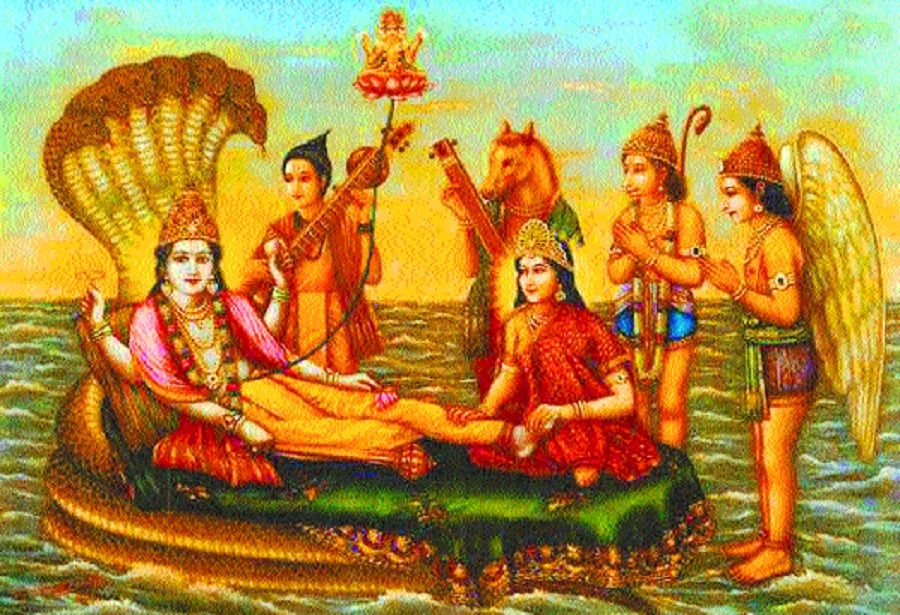Ashadhi Ekadashi: When Lord Vishnu starts Yoga Nidra
| Date :12-Jul-2019 |

By Rajendra Diwe:
Bhagwan Vishnu, the protector of the entire universe and supreme consciousness is all set to take ‘Yganidra’ from Ashadhi Ekadashi. In Veda, ‘Purush Sukta’ is the hymn that elaborated the transcendent totality of all creation as ‘Cosmic Person’, the universal consciousness animating all manifestation. This supreme consciousness is Lord Vishnu. The Rigveda glorified Lord Vishnu as ‘Na Te Vishno Jayamano Na Jaato Deva Mahimnah Paramantmap’ (O! Lord Vishnu, there is hardly any living being in the universe already born or planning to born, who realised the ultimate truth about you.) Lord Vishnu, therefore, termed as both manifest and un-manifest.
Vishnu represents ‘Sattvaguna’ and is the centripetal force as it were, responsible for sustenance, protection and maintenance of the created universe. Etymologically speaking, the word ‘Vishnu’ means ‘one who pervades, one who has entered into everything.’ So he is the transcendent as well the immanent reality of the universe. He is the inner cause and power by which things exist. According to Hindu scriptures, the 11th day of ‘Shukla Paksha’ of Ashadh month is a very auspicious day when Lord Vishnu starts His ‘Yoga Nidra’. This is the reason this day is celebrated as ‘Harishayani or Devashayani Ekadashi’. Vishnu’s sleep is considered epitome of the best meditating practice.
Hence, it is termed as ‘Yoga Nidra’. It starts on Ashadhi Ekadashi and ends on Kartiki Ekadashi. Therefore, the four month period of ‘Yoga Nidra’ is termed as ‘Chaturmas’. The tenure of four months has a strong connection with divinity and people find this a favorable time to attain the blessings of the Almighty. Chaturmas is observed by Buddhists, Hindus, and Jainists. No auspicious functions are performed during Chaturmas, especially marriage, mundan, yadnyopavit, shilanyas, gruha pravesh etc. It is believed that marriages conducted during Chaturmas may fail. The four Indian months Shravan, Bhadrapad, Ashwin and Kartik make ‘Chaturmas’.
Astrologically, Chaturmas starts when Sun enters in Karka rashi and Guru and Shukra gets debilitated. Saints, sages and sanyasis observe Chaturmas with full devotion. Sanyasis also perform Vyasa rituals during Chaturmas. During this time, they halt at particular places and provide discourses to the public. For household persons, it is a suitable time to perform fasts. Devotees also spend their time in recital of Mantras, bathing in holy rivers.
Charity during this period is believed to be auspicious. Fasts and other austerities help a person maintain good health and guard him/her from certain diseases that are caused due to onset of monsoon. Jain monks believe that numerous bugs are produced during the rainy season that corresponds with the period of Chaturmas. Moreover, there are insects that cannot be seen with naked eye and there is a possibility that humans may kill them, unknowingly. Hence, to incur minimal harm to other creatures, the monks prefer to stay in a village. There, they perform several austerities that include Maun Vrat (abstaining from speaking). Buddhists monks consider the Chaturmas period with an almost equal pattern as that of the Jains. The period of Chaturmas is also believed to be the time when Gautam Buddha stayed at the garden of King Bimbisara of Rajgir and delivered sermons to the ordinary public.






